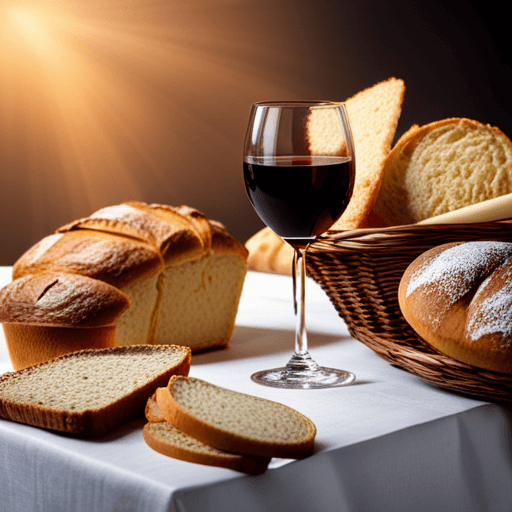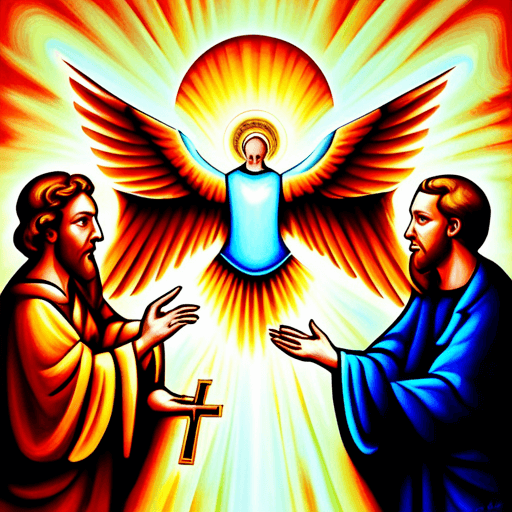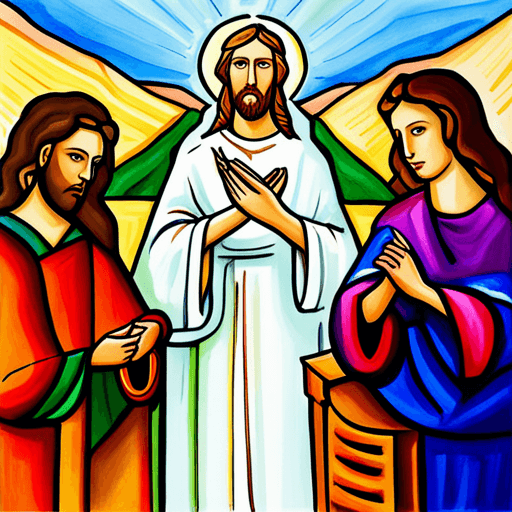Do you ever wonder about the deeper meanings behind the rituals and symbols of your faith? The Eucharist, also known as Communion or the Lord’s Supper, is a central sacrament in Christian worship. It involves the consumption of bread and wine that have been consecrated by a priest or minister. But what do these elements truly represent?
The choice of bread and wine as symbols in the Eucharist is not arbitrary. These staples of Mediterranean cuisine have deep roots in both Jewish and Greco-Roman cultures, which influenced early Christianity. Through their physical properties and associations with nourishment, sustenance, sacrifice, and celebration, bread and wine convey profound spiritual truths about Christ’s presence, sacrifice, unity with believers, and future hope.
In this article, we will explore the symbolic meaning of bread and wine in the Eucharist to deepen your understanding of this sacred ritual.
The Significance of the Eucharist in Christian Worship
You can feel the deep reverence and connection to God that fills the room as Christians come together to partake in this sacred ritual. The Eucharist, or Holy Communion as it’s sometimes called, has been an integral part of Christian worship since its inception.
It represents one of the most important moments in Jesus’ life, where he shared bread and wine with his disciples during the Last Supper before his crucifixion. The importance of participation in this ritual can’t be overstated.
By sharing in the bread and wine, Christians are not only symbolically consuming Christ’s body and blood but are also coming together as a community to reaffirm their faith and commitment to God. The history of the Eucharist is rich and varied, with different interpretations across various Christian denominations.
Nevertheless, its significance remains constant – it’s a powerful reminder of Christ’s sacrifice for humanity and an opportunity for believers to connect with one another on a deeply spiritual level.
The Choice of Bread and Wine as Symbols
As you partake in the holy ritual, have you ever stopped to wonder why these particular elements were chosen to represent the divine sacrifice?
The bread and wine symbolism has a rich history that dates back to ancient times. Bread was considered a staple food and represented sustenance, while wine was seen as a symbol of joy and celebration.
In Christianity, these symbols were given new meaning when Jesus used them during the Last Supper. The bread represents the body of Christ, which was broken for humanity’s sins. It is also a reminder of God’s provision for his people.
The wine represents the blood of Christ, which was shed on the cross for our salvation. It is also a symbol of joy and celebration because it signifies our redemption through Christ’s sacrifice.
As we partake in communion, we are reminded of God’s love for us and our need for forgiveness. The choice of bread and wine as symbols is not arbitrary but has deep theological significance that connects us to God’s grace and mercy.
The Symbolic Meaning of Bread in the Eucharist
Get ready to discover the ancient significance behind one of the essential elements in communion: bread. The use of bread as a symbol dates back to biblical times, where it was seen as a staple food and even mentioned in several Bible stories.
In fact, Jesus himself used bread as a metaphor for his body during the Last Supper. This act of breaking bread became a significant part of Christian tradition, and eventually evolved into what we know today as the Eucharist.
The history and origins of using bread in the Eucharist are rooted in cultural significance. Bread is often viewed as a representation of sustenance and nourishment, which aligns with the idea that Christ’s body provides spiritual nourishment to believers.
Additionally, bread has been used in various cultures throughout history to represent unity and community. By sharing bread together during communion, Christians are not only partaking in a religious ceremony but also coming together as a community bound by their faith.
Overall, the symbolic meaning behind using bread in the Eucharist goes beyond just its physical properties; it represents both spiritual nourishment and communal unity within Christianity.
The Symbolic Meaning of Wine in the Eucharist
Now it’s time to dive into the significance of that delicious cup of grape juice (or wine) you sip during communion.
Wine has been a part of religious rituals for thousands of years, and its use in the Eucharist can be traced back to Jesus himself at the Last Supper. In this context, wine represents the blood shed by Jesus on the cross for our salvation.
Just as bread symbolizes his body, wine is a powerful reminder of his sacrifice.
The cultural significance of wine in Christianity cannot be ignored either. It’s been used as a symbol of celebration, joy, and community since ancient times. In fact, many churches use only red wine during communion because it’s seen as a more fitting representation of Christ’s blood than white or rosé.
The act of sharing one cup also emphasizes unity among believers and reinforces the idea that we’re all part of one body in Christ.
Overall, the symbolic meaning behind wine in the Eucharist serves as a powerful reminder not only of Christ’s sacrifice but also of our shared identity as members of God’s family.
Deepening Your Understanding of the Eucharist through Symbolism
Delving into the significance of the Eucharist’s symbolism can offer a richer understanding of its spiritual and communal implications.
Exploring the ritualistic aspect of bread and wine in the Eucharist highlights their connection to Jesus’ last supper, where he broke bread and shared wine with his disciples. The breaking of bread represents Christ’s body being broken for humanity, while the wine symbolizes his blood shed on the cross for redemption. This act is not only symbolic but also serves as an invitation to participate in Christ’s sacrifice through partaking in communion.
Additionally, examining the historical context of bread and wine shows how these elements have been used throughout history to signify unity among believers. Communion has always been regarded as a way for Christians to come together and celebrate their faith as a community. By partaking in this ritual, individuals are reminded that they are all part of one body – that is, Christ’s body – bound by a common belief system.
Through this shared experience, believers become connected both spiritually and emotionally, leading to a greater sense of belonging within their religious community.
Frequently Asked Questions
What is the origin of the use of bread and wine in the Eucharist?
If you’re wondering about the origins of using bread and wine in the Eucharist, you’re not alone. The history of this practice dates back to the Last Supper, when Jesus shared bread and wine with his disciples.
Over time, this ritual evolved into a central part of Christian worship. The use of bread and wine also symbolizes the sacrifice that Jesus made for humanity’s sins – by consuming these elements during communion, Christians believe they’re commemorating and participating in that sacrifice.
While the precise details may have changed over time, the centrality of bread and wine in Christian worship has remained consistent throughout history.
Are there any variations in the use of bread and wine in different Christian denominations?
When it comes to the use of bread and wine in the Eucharist, there are actually quite a few variations across different Christian denominations. Cultural considerations often play a role in determining what elements are used for communion.
For example, some churches may use unleavened bread instead of regular bread due to cultural or historical reasons. Additionally, some denominations may offer alternative elements such as grape juice instead of wine for those who prefer not to consume alcohol.
Ultimately, while the symbolic meaning behind the Eucharist remains constant, the specific elements used can vary greatly depending on tradition and cultural context within each denomination.
What is the significance of the act of breaking the bread during the Eucharist?
When it comes to the act of breaking bread during the Eucharist, it holds a significant meaning for Christians. Breaking bread is not just a mere physical action but also bears spiritual nourishment.
The significance of breaking bread lies in its representation of unity and sharing among believers. It symbolizes the broken body of Jesus Christ on the cross, which was sacrificed for our sins. Additionally, it represents communion with Christ and fellow believers, emphasizing the importance of community and fellowship in one’s faith journey.
Therefore, breaking bread during Eucharist is not only an act of remembrance but also a reminder that we’re all one body in Christ.
Can non-Christians participate in the Eucharist?
If you’re wondering whether non-Christians can participate in the eucharist, there are both interfaith and theological implications to consider.
From an interfaith perspective, allowing non-Christians to take part in the sacrament could be seen as a gesture of inclusivity and respect for other religious traditions.
However, from a theological standpoint, the eucharist is considered a sacred ritual reserved only for those who have been baptized and confirmed into the Christian faith.
Ultimately, it’s up to individual churches and denominations to decide whether or not they will allow non-Christians to receive communion.
How does the symbolism of bread and wine in the Eucharist relate to the concept of sacrifice in Christianity?
When discussing the symbolism of bread and wine in the Eucharist, it’s impossible not to touch on the concept of sacrifice in Christianity. The sacrificial imagery is evident in the act of consuming the bread and wine, which are believed to be transformed into the body and blood of Christ through transubstantiation.
By partaking in this sacrament, Christians symbolically participate in Christ’s ultimate sacrifice on the cross. This idea reinforces their belief that Jesus died for their sins so that they may have eternal life. It also serves as a reminder to lead a life of selflessness and service to others, just as Christ did throughout his ministry.
As such, participating in the Eucharist is a fundamental aspect of Christian worship and an integral part of their sense of community with one another and with God.
Conclusion
Congratulations! You’ve now gained a deeper understanding of the symbolic meaning of bread and wine in the Eucharist.
As you reflect on this sacrament, remember that the bread represents Christ’s body, broken for us. The wine represents his blood, shed for our sins.
By partaking in the Eucharist and meditating on its symbolism, you can draw closer to God and feel more connected to your faith.
Remember to approach this sacrament with reverence and gratitude for all that Jesus has done for us.
May your understanding of the Eucharist continue to grow as you seek to deepen your relationship with God.




